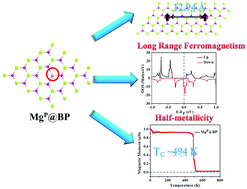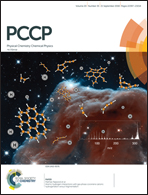High Curie temperature and half-metallicity in an atomically thin main group-based boron phosphide system: long range ferromagnetism†
Abstract
Transition metal-free magnetism and half-metallicity are currently drawing remarkable attention due to their potential future applications in spintronics devices. Using state-of-the-art density functional theory (DFT) calculations, we have considered Be and Mg incorporated in atomically thin boron phosphide (BP) systems for possible spintronics applications. Interestingly, our results reveal that Mg and Be substitution at P-sites exhibits ferromagnetism and half-metallicity. We also found long range ferromagnetism and a high Curie temperature (TC = ∼494 K) in the MgP@BP system; this Curie temperature is remarkably high amongst the existing main group-based 2D materials reported to date. The calculated magnetic anisotropy energy (MAE) is as high as 21.6 μeV per Mg. The stability study of the Mg-doped BP systems shows excellent dynamical, thermal and mechanical properties. Thus, a material with this high Curie temperature can function at elevated temperatures for future nano-spintronics device applications.



 Please wait while we load your content...
Please wait while we load your content...